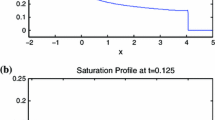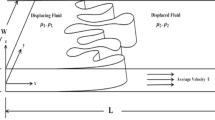Abstract
We use linear stability theory to investigate the effect of fluid compressibility on interface stability during a dissipative displacement (Darcy flow). We find that compressibility changes the perturbation growth rate as a function of perturbation wavenumber. Our results indicate that both favorable (less than unity) and unfavorable (greater than unity) mobility ratios will always lead to positive maximum growth rate, which traditionally is recognized as the criterion for instability. We conclude, however, that in the case of favorable mobility ratio, the maximum perturbation growth rate is always smaller than the unperturbed growth rate naturally existing in compressible displacements. The interface will still be stable because the perturbation will never exceed the background flow. Therefore, compressibility does not change the stability of displacements, which is ultimately determined by mobility ratio.



Similar content being viewed by others
Availability of Data and Materials
The datasets generated during the current study are available from the corresponding author on reasonable request.
Code Availability
The codes generated during the current study are available from the corresponding author on reasonable request.
References
Alvarez-Lacalle, E., Ortin, J., Casademunt, J.: Nonlinear Saffman–Taylor instability. Phys. Rev. Lett. 92, 054501 (2004)
Araque-Martinez, A.N., Lake, L.W.: The Effect of Compressibility and Outer Boundaries on the Onset of Viscous Fingering. In Day 4 Thu, October 29, 2020; SPE: Virtual, p D041S059R002. https://doi.org/10.2118/201310-MS (2020)
Carslaw, H.S., Jaeger, J.C.: Conduction of Heat in Solids, 2nd edn. Oxford University Press, London (1959)
Chuoke, R.L., Van Meurs, P., van der Poel, C.: The instability of slow, immiscible, viscous liquid–liquid displacements in permeable media. Trans. AIME 216, 188 (1959)
Collins, R.E.: Flow of Fluids Through Porous Materials. Reinhold Pub. Corp, New York (1976)
Coussot, P.: Saffman–Taylor instability in yield-stress fluids. J. Fluid Mech. 380, 363–376 (1999). https://doi.org/10.1017/S002211209800370X
Dias, E.O., Miranda, J.A.: Wavelength selection in Hele–Shaw flows: a maximum-amplitude criterion. Phys. Rev. E 88(1), 013016 (2013). https://doi.org/10.1103/PhysRevE.88.013016
Drazin, P.: Kelvin–Helmholtz instability of finite amplitude. J. Fluid Mech. 42(2), 321–335 (1970). https://doi.org/10.1017/S0022112070001295
Gerwin, R.A.: Stability of the interface between two fluids in relative motion. Rev. Mod. Phys. 40, 652 (1968)
Homsy, G.M.: Viscous fingering in porous media. Ann. Rev. Fluid Mech. 19, 271–311 (1987)
Jin, L., Le, T.T., Fukumoto, Y.: “Frictional effect on stability of discontinuity interface in tangential velocity of a shallow-water flow. Phys. Lett. A 383(26), 125839 (2019)
Kim, H., Funada, T., Joseph, D.D., Homsy, G.M.: Viscous potential flow analysis of radial fingering in a Hele–Shaw cell. Phys. Fluids 21(7), 074106 (2009). https://doi.org/10.1063/1.3184574
Krechetnikov, R., Marsden, J.E.: Dissipation-induced instabilities in finite dimensions. Rev. Mod. Phys. 79, 519–553 (2007)
Lake, L.W., Johns, R., Rossen, B., Pope, G.: Fundamentals of Enhanced Oil Recovery. Society of Petroleum Engineers, Richardson (2014)
Le, T.T., Koch, T.: Interface stability of compressible fluids in porous media. Phys. Fluids 33, 084102 (2021)
Mora, S., Manna, M.: Saffman–Taylor instability for generalized Newtonian Fluids. Phys. Rev. E 80, 016308 (2009)
Nagel, M., Gallaire, F.: A new prediction of wavelength selection in radial viscous fingering involving normal and tangential stresses. Phys. Fluids 25(12), 124107 (2013). https://doi.org/10.1063/1.4849495
Park, C.W., Homsy, G.M.: Two-phase displacement in Hele Shaw cells: theory. J. Fluid Mech. 139, 291–308 (2006). https://doi.org/10.1017/S0022112084000367
Parlange, J.-Y., Hill, D.E.: Theoretical analysis of wetting front instability in soils. Soil Sci. 22(4), 236–239 (1976). https://doi.org/10.1097/00010694-197610000-00008
Pascal, H.: Rheological effects of non-newtonian behavior of displacing fluids on stability of a moving interface in radial oil displacement mechanism in porous media. Int. J. Eng. Sci. 24(9), 1465–1476 (1986). https://doi.org/10.1016/0020-7225(86)90157-6
Pihler-Puzović, D., Périllat, R., Russell, M., Juel, A., Heil, M.: Modelling the suppression of viscous fingering in elastic-walled Hele–Shaw cells. J. Fluid Mech. 731, 162–183 (2013). https://doi.org/10.1017/jfm.2013.375
Plateau, J.A.F.: Experimental and theoretical statics of liquids subject to molecular forces only 427 (2005)
Rayleigh, L.: Investigation of the character of the equilibrium of an incompressible heavy fluid of variable density. Proc. Lond. Math. Soc. 1, 170–177 (1882). https://doi.org/10.1112/plms/s1-14.1.170
Saffman, P.: Viscous fingering in Hele–Shaw cells. J. Fluid Mech. 173, 73–94 (1986). https://doi.org/10.1017/S0022112086001088
Saffman, P.G., Taylor, S.G.I.: The penetration of a fluid into a porous medium or Hele–Shaw cell containing a more viscous liquid. Proc R Soc Lond Ser A Math Phys Sci 245(1242), 312–329 (1958). https://doi.org/10.1098/rspa.1958.0085
Sharp, D.H.: An overview of Rayleigh–Taylor instability. Physica D 12, 3 (1984)
Sorbie, K.S., Al Ghafri, A.Y., Skauge, A., Mackay, E.J.: On the modelling of immiscible viscous fingering in two-phase flow in porous media. Trans Porous Med. 135, 331–359 (2020). https://doi.org/10.1007/s11242-020-01479-w
Tabeling, P., Zocchi, G., Libchaber, A.: An experimental study of the Saffman–Taylor instability. J Fluid Mech 177, 67–82 (1987). https://doi.org/10.1017/S0022112087000867
Taylor, S.G.I.: The instability of liquid surfaces when accelerated in a direction perpendicular to their planes. I. Proc. r. Soc. Lond. A 201(1065), 192–196 (1950). https://doi.org/10.1098/rspa.1950.0052
White, A.R., Ward, T.: CO2 sequestration in a radial Hele–Shaw cell via an interfacial chemical reaction. Chaos 22(3), 037114 (2012). https://doi.org/10.1063/1.4754021
Acknowledgements
We acknowledge many helpful discussions with Dr. Michael Marder. Larry W. Lake holds the Shahid and Sharon Ullah chair.
Funding
Partial financial support was received from the Shahid and Sharon Ullah chair.
Author information
Authors and Affiliations
Contributions
All authors contributed to the study conception and design. Material preparation, data collection and analysis were performed by Yuzheng Lan, David DiCarlo and Larry Lake. The first draft of the manuscript was written by Yuzheng Lan, and all authors commented on previous versions of the manuscript. All authors read and approved the final manuscript. David DiCarlo is the corresponding author of this submission.
Corresponding author
Ethics declarations
Conflict of interest
The authors have no conflicts of interest to declare that are relevant to the content of this article.
Additional information
Publisher's Note
Springer Nature remains neutral with regard to jurisdictional claims in published maps and institutional affiliations.
Appendix: Long-Wave Asymptotes
Appendix: Long-Wave Asymptotes
We will take \({n}_{y}=0\) and look at Eqs. 53 and 54 under long-wave asymptotic condition (\({n}_{y}\to 0\)).
After substitution, Eqs. 57 and 58 become
Upon some algebra we arrive at polynomial.
This is a third-order polynomial in terms of \({n}_{xD}^{I}\), which can be easily solved analytically. Among the three roots to this equation, only one is chosen both \({n}_{xD}^{I}\) and \({n}_{xD}^{II}\) having positive real parts in order to satisfy the requirement set by Eq. 37.
Considering its nonlinearity, roots to Eq. 60 serve well as proper initial guesses for us to solve Eqs. 53 and 54. We are now fully equipped to solve Eqs. 53 and 54. The behavior of decay rate at this limit is shown in Fig. 4.
Rights and permissions
Springer Nature or its licensor holds exclusive rights to this article under a publishing agreement with the author(s) or other rightsholder(s); author self-archiving of the accepted manuscript version of this article is solely governed by the terms of such publishing agreement and applicable law.
About this article
Cite this article
Lan, Y., DiCarlo, D. & Lake, L.W. Interface Stability of Compressible Fluid Displacements in Porous Media. Transp Porous Med 144, 699–713 (2022). https://doi.org/10.1007/s11242-022-01831-2
Received:
Accepted:
Published:
Issue Date:
DOI: https://doi.org/10.1007/s11242-022-01831-2





